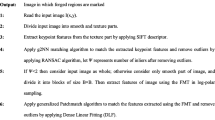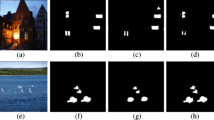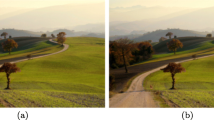Abstract
Detection of copy-move forgery has recently attracted much attention. During the past decade, two categories of methods, namely block-based and feature point-based methods, gradually developed. Compared with block-based methods, feature point-based methods exhibit remarkable performance with respect to robustness and computational cost. However, the feature point-based methods are still incomplete especially in terms of forgeries involving small smooth regions. In this paper, we solve this problem by cautiously supplementing redundant feature points and feature fusion. We propose two-stage feature detection to obtain better feature coverage and enhance the matching performance by combining the MROGH and HH descriptor. We evaluated our method on two representative datasets. We use precision, recall and F 1 score to quantitatively evaluate the performance. Experimental results confirm the efficacy of our work.












Similar content being viewed by others
References
Amerini I, Ballan L, Caldelli R, Del Bimbo A, Del Tongo L, Serra G (2013) Copy-move forgery detection and localization by means of robust clustering with j-linkage. Signal Process Image Commun 28(6):659–669
Amerini I, Ballan L, Caldelli R, Del Bimbo A, Serra G (2011) A sift-based forensic method for copy–move attack detection and transformation recovery. IEEE Trans Inf Forensic Secur 6(3):1099–1110
Bashar M, Noda K, Ohnishi N, Mori K (2010) Exploring duplicated regions in natural images. IEEE Trans Image Process PP(99):1–1. doi:10.1109/TIP.2010.2046599
Bay H, Tuytelaars T, Van Gool L (2006) Surf: Speeded up robust features. In: Computer vision–ECCV 2006. Springer, pp 404–417
Bayram S, Sencar H, Memon N (2009) An efficient and robust method for detecting copy-move forgery. In: IEEE international conference on acoustics, speech and signal processing, ICASSP 2009, pp 1053–1056. doi:10.1109/ICASSP.2009.4959768, (to appear in print)
Bravo-Solorio S, Nandi A (2011) Exposing duplicated regions affected by reflection, rotation and scaling. In: IEEE international conference on acoustics, speech and signal processing (ICASSP), pp 1880–1883. doi:10.1109/ICASSP.2011.5946873, (to appear in print)
Brown M, Szeliski R, Winder S (2005) Multi-image matching using multi-scale oriented patches. In: IEEE computer society conference on computer vision and pattern recognition, CVPR 2005, vol 1, pp 510–517. doi:10.1109/CVPR.2005.235
Chen L, Lu W, Ni J, Sun W, Huang J (2013) Region duplication detection based on harris corner points and step sector statistics. J Vis Commun Image Represent 24(3):244–254
Christlein V, Riess C, Jordan J, Riess C, Angelopoulou E (2012) An evaluation of popular copy-move forgery detection approaches. IEEE Trans Inf Forensics Secur 7(6):1841–1854. doi:10.1109/TIFS.2012.2218597
Fan B, Wu F, Hu Z (2011) Aggregating gradient distributions into intensity orders: A novel local image descriptor. In: IEEE conference on computer vision and pattern recognition (CVPR). IEEE, pp 2377–2384
Fischler MA, Bolles RC (1981) Random sample consensus: a paradigm for model fitting with applications to image analysis and automated cartography. Commun ACM 24(6):381–395
Fridrich AJ, Soukal BD, Lukáṡ AJ (2003) Detection of copy-move forgery in digital images. In: Proceedings of digital forensic research workshop. Citeseer
Gkalelis N, Mezaris V (2014) Video event detection using generalized subclass discriminant analysis and linear support vector machines. In: Proceedings of international conference on multimedia retrieval, vol 25. ACM
Guo JM, Liu YF, Wu ZJ (2013) Duplication forgery detection using improved daisy descriptor. Expert Syst Appl 40(2):707–714. doi:10.1016/j.eswa.2012.08.002. http://www.sciencedirect.com/science/article/pii/S0957417412009633
Li Y (2013) Image copy-move forgery detection based on polar cosine transform and approximate nearest neighbor searching. Forensic Science International 224(1–3):59–67. doi:10.1016/j.forsciint.2012.10.031. http://www.sciencedirect.com/science/article/pii/S0379073812004859
Lowe DG (2004) Distinctive image features from scale-invariant keypoints. Int J Comput Vis 60(2):91–110
Luo W, Huang J, Qiu G (2006) Robust detection of region-duplication forgery in digital image. In: 18th International Conference on Pattern recognition, ICPR 2006. IEEE, pp 746–749
Mahdian B, Saic S (2007) Detection of copy–move forgery using a method based on blur moment invariants. Forensic Sci Int 171(2):180–189
Noble JA (1988) Finding corners. Image Vis Comput 6(2):121–128
Pan X, Lyu S (2010) Region duplication detection using image feature matching. IEEE Trans Inf Forensic Secur 5(4):857–867
Popescu AC, Farid H (2004) Exposing digital forgeries by detecting duplicated image regions. Department Computer Science, Dartmouth College, Technical Report. TR2004-515
Ryu SJ, Lee MJ, Lee HK (2010) Detection of copy-rotate-move forgery using zernike moments. In: Bhme R, Fong P, Safavi-Naini R (eds) Information Hiding, Lecture Notes in Computer Science, vol 6387. Springer Berlin Heidelberg, pp 51–65
Scherp A, Mezaris V (2014) Survey on modeling and indexing events in multimedia. Multimedia Tools Appl 70(1):7–23. doi:10.1007/s11042-013-1427-7
Shivakumar B, Baboo LDSS (2011) Detection of region duplication forgery in digital images using surf. IJCSI Int J Comput Sci Issues 8(4)
Tola E, Lepetit V, Fua P (2010) Daisy: An efficient dense descriptor applied to wide-baseline stereo. IEEE Trans Pattern Anal Mach Intell 32(5):815–830
Tuytelaars T (2010) Dense interest points. In: IEEE conference on computer vision and pattern recognition (CVPR). IEEE, pp 2281–2288
Van De Weijer J, Schmid C (2006) Coloring local feature extraction. In: Computer vision–ECCV 2006. Springer, pp 334–348
Acknowledgments
The authors would like to thank Yuenan Li and Irene Amerini for sharing their copy-move forgery detection code. We also thank Mahmoud Emam and all the anonymous reviewers for their helpful comments and suggestions. Additionally, this work is supported by the National Natural Science Foundation of China (61100187 and 61361166006) and the China Postdoctoral Science Foundation (2011M500666).
Author information
Authors and Affiliations
Corresponding author
Rights and permissions
About this article
Cite this article
Yu, L., Han, Q. & Niu, X. Feature point-based copy-move forgery detection: covering the non-textured areas. Multimed Tools Appl 75, 1159–1176 (2016). https://doi.org/10.1007/s11042-014-2362-y
Received:
Revised:
Accepted:
Published:
Issue Date:
DOI: https://doi.org/10.1007/s11042-014-2362-y




